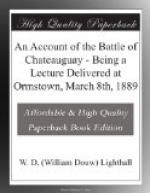Hampton had another slave-holding South Carolinian by his side, young Brigadier-General George Izard, son and descendant of aristocrats and statesmen, well-educated in the soldier’s profession, college-bred, travelled, and who had served in the French Army. Izard led the main column at the battle shortly to ensue.[10]
Another officer of the circle—who seems to have been the ablest—was Colonel James Purdy, on whom the brunt of the American work and fighting were to fall, and who seems to have done his best in a struggle against natural difficulties and against the incompetency of both his commander and men.
When Hampton moved to Four Corners, Lieut-Colonel De Salaberry, with the Canadian Voltigeurs, moved in like manner westward to the region of the Chateauguay and English Rivers. The Voltigeur troops were French-Canadians with a small sprinkling of British. Their organization was as follows:—Sir George Prevost, on the approach of war, May 28th, 1812, ordered the levy of four French volunteer battalions, to be made up of unmarried men from 18 to 25 years old. They were to be choice troops, and trained like regulars. Charles Michel d’Irumberry De Salaberry, then high in the regard of his people as a military hero, was chosen to rally the recruits, issued a stirring poster calling the French-Canadians to arms, and acted with such extraordinary energy that the troops were in hand in two days.
De Salaberry was a perfect type of the old French-Canadian military gentry, a stock of men of whom very little remains, a breed of leaders of, on the whole, more vigorous forms, more active temperaments, than the average—descendants inheriting the qualities of the bravest and most adventurous individuals of former times. They were the natural result of the feudal regime, with which they have passed away. Though a gentry, they were a poor one, possessed of little else than quantities of forest lands. The officers of the Voltigeurs were selected out of the same class, united with a number of English of similar stamp. De Salaberry himself was born in the little cottage manor-house of Beauport, near Quebec, on the 19th of Nov., 1778.[11] Taking to soldiering like a duck to water when very young, he enrolled as volunteer in the 44th. At sixteen, the Duke of Kent, who was then in Canada, and delighted in friendly acts towards the seigneurs, got him a commission in the 60th, with which regiment he left at once for the West Indian Isle of Dominica. There he saw terrible service, for all the men of his battalion except three were killed or wounded during the seige of Fort Matilda. Nevertheless, the young fellow kept gay. “Our uniforms,” he wrote to his father, “cost very dear; but I have received L40, and with that I am going to give myself what will make a fine figure.” “This fine large boy of sixteen years,” says Benjamin Sulte in his History of the French-Canadians, “strong as a Hercules ... with smiling face ... made a furore at parties.... As he was never sick, they employed him everywhere. Fevers reduced his battalion to 200 men, but touched not him.” Though so young, he was charged with covering the evacuation of Fort Matilda.[12]




